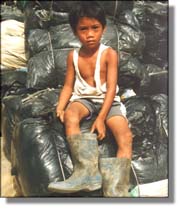Bangkok July 19, 2000
Response to Landfill Collapse in Payatas, Philippines
 The waste dump in Payatas is Manila's main waste dump with garbage piled as high
as seven stories in some places. Impoverished squatters, including many
children, live in the area and pick through the dump to collect items they can
sell. When part of the garbage mountain collapsed on July 11, partly weakened
from a recent typhoon, garbage crashed down onto the huts and shacks below and
caught fire, apparently ignited by fallen power cables and stoves in the huts.
The waste dump in Payatas is Manila's main waste dump with garbage piled as high
as seven stories in some places. Impoverished squatters, including many
children, live in the area and pick through the dump to collect items they can
sell. When part of the garbage mountain collapsed on July 11, partly weakened
from a recent typhoon, garbage crashed down onto the huts and shacks below and
caught fire, apparently ignited by fallen power cables and stoves in the huts.
Many people were trapped and killed and more are still missing.
- Unfortunately, this is the latest in a long row of accidents related to
inadequate solid waste management in the region, says UNEP's Regional Director,
Mr. Nirmal Andrews. We have seen many tragic examples of the impact on humans as
well as on the environment resulting from inadequate or poorly planned handling
of waste. The sudden appearance of radioactive waste on municipal dumps in
Thailand, the uncontrolled export of hazardous chemicals to Cambodia, and now
finally the waste dump collapse in the Philippines are only a few warning
signals of an increasing number of waste-related incidents.
UNEP's Regional Office for Asia and the Pacific located in Bangkok, Thailand,
and UNEP's International Environmental Technology Center in Osaka, Japan, are
further reviewing actions to accelerate the work of concerned authorities in the
region to address problems related to solid waste management. Several supports
are already provided by UNEP, including training workshops, "best practice"
guidelines and a database on Environmentally Sound Technologies for integrated
waste management.
-But it is obvious that more needs to be done. At a first stage we want to learn
from the disaster in Payatas about the underlying causes and what actions can be
taken in the short perspective to prevent this accident to be repeated
elsewhere.
In the longer perspective we need to draw the attention of concerned
authorities to appropriate policies, which can be implemented and what actions
can be taken to achieve safe and sustainable waste management systems.
The ever-increasing population and rapid urbanization in the region cause the
proliferation of waste. At the same time the complex relationship between waste
generation, sustainable development, sustainable livelihood and environmental
protection calls for an integrated approach that takes all aspects into
consideration.
-We have since long passed the stage where waste can only be seen as an
environmental problem, says Mr. Andrews. There are economic and social factors
as well, that need to be integrated in the approach to waste management in any
modern society. It is our call to assist Governments in the region to seek
long-term solutions to this matter.
by Niclas Svenningsen , Environmental Affairs Officer at UNEP ROAP in Bangkok
Photos © and following text from: Fields International, Inc.
Sarah Project / Payatas
 Children Living in The Garbage
Children Living in The Garbage
It may be hard for many people to imagine what it would be like to live in such conditions, but that's the daily reality for the thousands who live at the Payatas dump. Many of the residents of Payatas make their living by digging through the influx of "fresh" trash, scavenging for plastic, cardboard, paper, wood, glass, metal and other items that can be sold to recycling agents.
The meager earnings made by one person are not enough to buy food for even for a day. Whole families are forced to climb the mountain each day, hoping that together they can earn enough to feed everyone. Children as young as four years old must work in their daily struggle for survival.